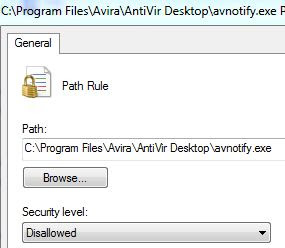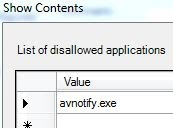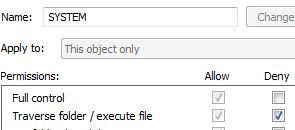The notification message, or rather the pop-up ads, of free edition of Avira Anti-Virus product displayed whenever auto-updater runs to update the anti-virus signature database, which is a daily routine. Thus, the upgrade to Avira AntiVir Premium or Avira Premium Security Suite pop-up notifier window is shown everyday from notification area (system tray).
The Avira upgrade pop-up notifier “almost full screen” nag screen is the job responsibility by avnotify.exe. It’s possible to disable and remove the annoying Avira popup nag screen by using one of the following methods. However, do note that the hack below is violating free Avira AntiVir EULA or license terms.
Method 1: Disable or Restrict avnotify.exe From Running or Executing with Local Security Policy Editor
Hint: Local Security Policy settings are among the security settings contained in the Local Group Policy Editor GPO. Thus, it works only Windows 2000, Windows XP Professional, Windows Vista Business, Enterprise and Ultimate Edition and Windows 7 Professional, Enterprise and Ultimate Edition, which has Local Group Policy Editor support.
1. Run secpol.msc, or alternatively, go to Control Panel -> Administrative Tools -> Local Security Policy.
2. Try to expand the Software Restriction Policies tree branch. Skip this step if both “Security Levels” and “Additional Rules” sub-branches are already created below Software Restriction Policies already.
Else, right click on Software Restriction Policies and select New Software Restriction Policies.
3. Right Click on Additional Rules and select New Path Rule.
4. Enter the full path to avnotify.exe in the Path: text box. It’s possible to click on Browse button to locate the avnotify.exe exectable.
Typically, avnotify.exe is located in %SystemDrive%\Program Files\Avira\AntiVir PersonalEdition Classic\avnotify.exe or %SystemDrive%\Program Files\Avira\AntiVir Desktop\avnotify.exe. In 64-bit OS, Program Files folder should be Program Files (x86) instead.
5. Set the Security level drop-down menu as Disallowed.

6. Click OK when done.
Method 2: Disallow or Disable avnotify.exe From Running or Executing with Local Group Policy Editor
Hint: Similar to Local Security
Policy Editor, Local Group Policy Editor is only included in some Windows versions. Thus, it works only Windows 2000, Windows XP Professional, Windows Vista Business, Enterprise and Ultimate Edition and Windows 7 Professional, Enterprise and Ultimate Edition.
* Run GPEdit.msc.
* Navigate to User Configuration > Administrative Templates > System.
* Double click on Don’t run specified Windows applications setting.
* Click on Enabled radio button if it’s not yet enabled.
* Click on Show button.
* Type in avnotify.exe in the Value column.

* Click OK when done.
Method 3: Remove Execute Permissions on avnotify.exe
Hint: Works in most editions and versions of Windows. Some system may requires user to login to Safe Mode (restart computer and press F8 to select Safe Mode) to perform operation below.
1. Sign in to Windows desktop using the Administrator account.
2. Open Windows Explorer.
3. Navigate to the folder location for avnotify.exe.
For Avira version 9, it’s likely to be C:\Program Files\Avira\AntiVir Desktop\avnotify.exe and C:\Program Files\Avira\AntiVir PersonalEdition Classic\avnotify.exe for earlier version. Note that 64-bit operating system should navigate to Program Files (x86) folder instead.
4. Right click on avnotify.exe and select Properties.
5. Go to Security tab.
6. Click on Advanced button.
7. Under Permissions tab, click on Change Permissions button (only if applicable), and then select and highlight SYSTEM user, and click on Edit button.
8. Tick the Deny check box for Traverse folder / execute file rights.

9. Click OK when done.
Tip: In 32-bit and 64-bit Windows 7 or Vista, it’s possible to directly deny Read & execute permission in Security tab. However, some users reported that doing so may cause Avira to request for system reboot after each update.
Method 4: Suppress Avira Notifier Popup Nag Screen with Registry Registration Files
Hint: Works for all editions and versions of Windows.
Copy and paste the following code into a text file, and save it as with a file name with .reg extension. Then run the file to merge the value to system registry. Note that user may need to change the code below to reflect the actual path to avnotify.exe located on local system.
For Windows 7:
Windows Registry Editor Version 5.00
[HKEY_LOCAL_MACHINE\SOFTWARE\Policies\Microsoft\Windows\safer\codeidentifiers\0\Paths\{60973e1d-3660-4012-856a-97a92f467003}]
"LastModified"=hex(b):b7,94,f1,01,52,26,ca,01
"Description"="Disable Avira PopUp"
"SaferFlags"=dword:00000000
"ItemData"="C:\\Program Files\\Avira\\AntiVir Desktop\\avnotify.exe"
For Windows XP und Windows Vista:
Windows Registry Editor Version 5.00
[HKEY_LOCAL_MACHINE\SOFTWARE\Policies\Microsoft\Windows\safer\codeidentifiers\0\Paths\{f2425885-ad5b-4f27-bdff-9b0a7aba5940}]
"Description"=""
"SaferFlags"=dword:00000000
"ItemData"="C:\\Program Files\\Avira\\AntiVir Desktop\\avnotify.exe"
Method 5: Change Update Job Frequency to Daily At A Particular Time
Some users reported that changing the the Avira update job with frequency set to Daily at a particular time can eliminate Avira notifier pop up window. It’s also possible to edit the existing update to this mode.






https://mydigiinfo.blogspot.com/2009/11/remove-or-disable-avira-free-antivir.html?showComment=1259308883253#c8622649288034894360'> November 27, 2009 at 12:01 AM
Avira Home Edition - Free Antivirus represents the best FREE antivirus protection currently available on the market.